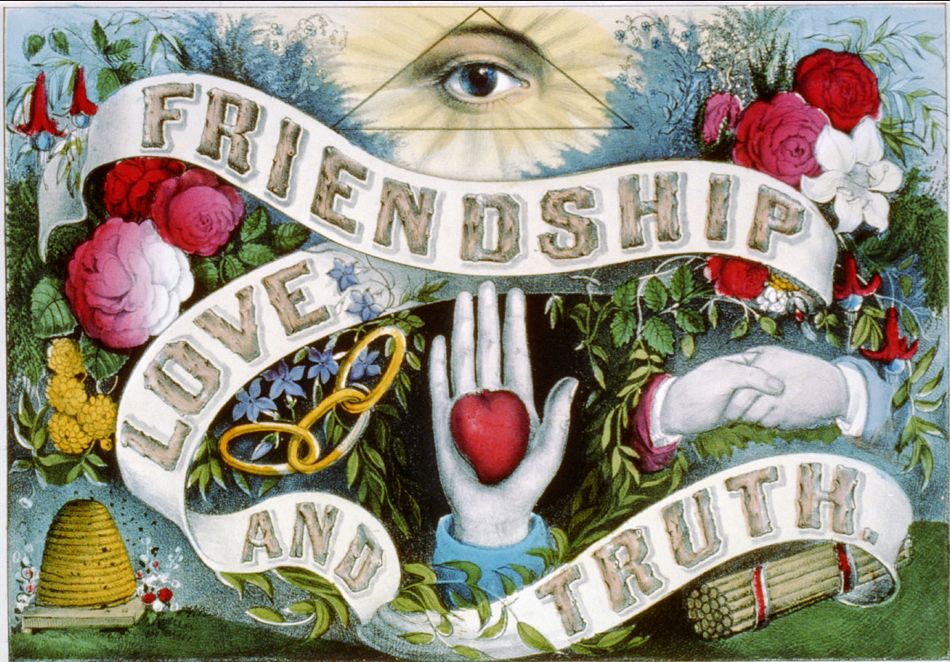Are the Odd Fellows Really All That Odd?

The Odd Fellows are based on the ideals of "Amicitia Amor et Veritas," or "Friendship, Love and Truth."
“We keep’em creaky, so nobody can sneak up on you!”
Kenny Browning scales the rickety staircase of Lodge 225, on 14th Street near Heights Boulevard, the red brick building with a swinging sign that’s housed Houston’s Odd Fellows since 1928. We’ve already perused the front hall, a quasi-museum packed with dusty flags, decorative furniture, and portraits of famous members long since passed (Franklin Roosevelt, John Nance Garner, Wyatt Earp). We’ve weaved through the utilitarian kitchen, where 25 locals are raiding a well-stocked fridge and noshing on cookies set out for their monthly meet-and-greet.
On the second floor, we reach a door fitted with an ornate knocker. Fifteen years ago, behind this secured entryway, Browning and his pals improbably resuscitated a chapter of an otherwise moribund fraternal organization. Our host glances over his shoulder, jiggles the lock, and leads us into the mysterious inner sanctum.
The Odd Fellows are an anachronism, a civic society that started 300 years ago in England and crossed the Atlantic in 1819. Membership—like that of the Elks or Shriners—peaked at around 3.5 million during your great-grandfather’s time, before television and suburban sprawl, two-parent working households and Facebook. These days, only a handful of lodges operate in Texas. (One is in Pasadena.) When Browning stumbled into Lodge 225, there weren’t even enough dues-paying Houstonians to form a five-person quorum.
Stocky and goateed, like Guy Fieri but scrubbed of the awfulness, Browning identified with the Odd Fellows’ commitment to community service. He felt those centuries-old values—honoring the dead, protecting the widow, feeding the orphan—were simpatico with the Art Car movement, of which he was an active participant, and of Burning Man, of which he was a dutiful attendee. That he appreciated costumes and peculiar rituals only sealed the deal.
Over the next few years, Browning and his friends picked the brains of the remaining old guard and recruited dozens of new Odd Fellows, tapping into members of the Art Car pipeline and Houston’s broader arts scene, male and female: Traditionally, women Odd Fellows have organized their own auxiliary groups, called Rebekah Assemblies, but here they participate fully in all Lodge 225 activities.
To join, all you had to do was attend two meetings, pay a $50 annual fee, prove you weren’t a “murderer or something,” and sit through an elaborate (and secretive) initiation ceremony. The group purchased their Heights clubhouse in 2005, assuming responsibility for some $30,000 in unpaid property taxes. Membership is now 60 strong, mixed-gender and mostly middle-aged, with a few 30-somethings mixed in.
Folks on 14th Street will gladly chat about all the admirable volunteerism they do: shifts at the food bank, grave tending at Olivewood Cemetery, the Oktoberfest parties and chili cook-offs they organize, the scholarships they hope to endow. “It’s a chance to get out of the house,” says Paul Jennings, the chapter’s understated Grand Noble (aka president). But when we ask for specifics about unusual Odd Fellow traditions—the occult?—we are met with smiles and evasions. “There are misconceptions,” Browning says. “They think we’re bleeding goats and all that kind of stuff. It’s not nearly as weird as you can imagine.”
Browning flicks on the lights of the second-floor meeting space. Walking inside feels like stepping out of a time machine. The windows are covered by maroon drapes, the tile floor scuffed. Vintage banners and faded black-and-white photographs pepper the Carolina blue walls. The Grand Noble’s wooden podium, throne-like, rests on the far end. Back in the day, the lodge held sock hops and professional wrestling matches up here. Browning tells us the group has plans to peel back the drop ceiling and see what’s underneath. At that, it seems we have come as far as a regular fellow can go. Browning and Terry Brooks, who’s joined us on the tour, have no intention of showing us the massive “regalia room,” padlocked in the corner, where all of their uniforms and salvaged mementos are currently stored.
Aside from the camaraderie, Brooks sees another benefit to his Odd Fellowship. “I always tell people, if you’re a paid up member of this lodge, you can say you’re a property owner in the Heights.”




